2016 Peugeot 308 fog light
[x] Cancel search: fog lightPage 12 of 398

10
308_en_Chap00c_eco-conduite_ed02-2015
Optimise the use of your gearbox
With a manual gearbox, move off gently and change up without waiting.
During acceleration change up early.
With an automatic or electronic gearbox, give preference to automatic
mode and avoid pressing the accelerator pedal heavily or suddenly.
Control the use of your electrical
equipment
Before moving off, if the passenger compartment is too warm, ventilate it
by opening the windows and air vents before using the air conditioning.
Above 30 mph (50 km/h), close the windows and leave the air vents
open.
Remember to make use of equipment that can help keep the
temperature in the passenger compartment down (sunroof and window
blinds...).
Switch off the air conditioning, unless it has automatic regulation, as
soon as the desired temperature is attained.
Switch off the demisting and defrosting controls, if not automatic.
Switch off the heated seat as soon as possible.
Switch off the headlamps and front foglamps when the level of light
does not require their use.
Avoid running the engine before moving off, particularly in winter; your
vehicle will warm up much faster while driving.
As a passenger, if you avoid connecting your multimedia devices
(film, music, video game...), you will contribute towards limiting the
consumption of electrical energy, and so of fuel.
Disconnect your portable devices before leaving the vehicle.
eco-driving
eco-driving is a range of everyday practices that allow the motorist to optimise their fuel consumption and CO2 emissions.
Drive smoothly
Maintain a safe distance between vehicles, use engine braking rather
than the brake pedal, and press the accelerator progressively. these
practices contribute towards a reduction in fuel consumption and
CO
2 emissions and also helps reduce the background traffic noise.
If y
our vehicle has cruise control, make use of the system at speeds
above 25 mph (40 km/h) when the traffic is flowing well.
the g
ear shift indicator invites you engage the most suitable gear: as
soon as the indication is displayed in the instrument panel, follow it
straight away.
For vehicles fitted with an electronic or automatic gearbox, this
indicator appears only in manual mode.
eco-driving
Page 16 of 398

14
Operation indicator lamps
If one of the following indicator lamps comes on in the instrument panel and/or instrument panel screen, this confirms that the corresponding system has come into operation.
Warning / indicator lampStateCause Action / Observations
Left-hand
direction indicatorflashing with buzzer.the l ighting stalk is pushed down.
Right-hand
direction indicatorflashing with buzzer.the lighting stalk is pushed up.
Sidelamps fixed.
the l
ighting stalk is in the
"Sidelamps" position.
Dipped beam
headlamps fixed.
the l
ighting stalk is in the "Dipped
beam headlamps" position.
Main beam
headlamps fixed.
the l
ighting stalk is pulled towards
you. Pull the stalk to return to dipped beam headlamps.
Front foglamps fixed.
the f
ront foglamps are switched on.
tur
n the ring on the stalk rear wards twice to switch off
the front foglamps.
For more information on the lighting controls, refer to the corresponding section.
Instruments
Page 110 of 398
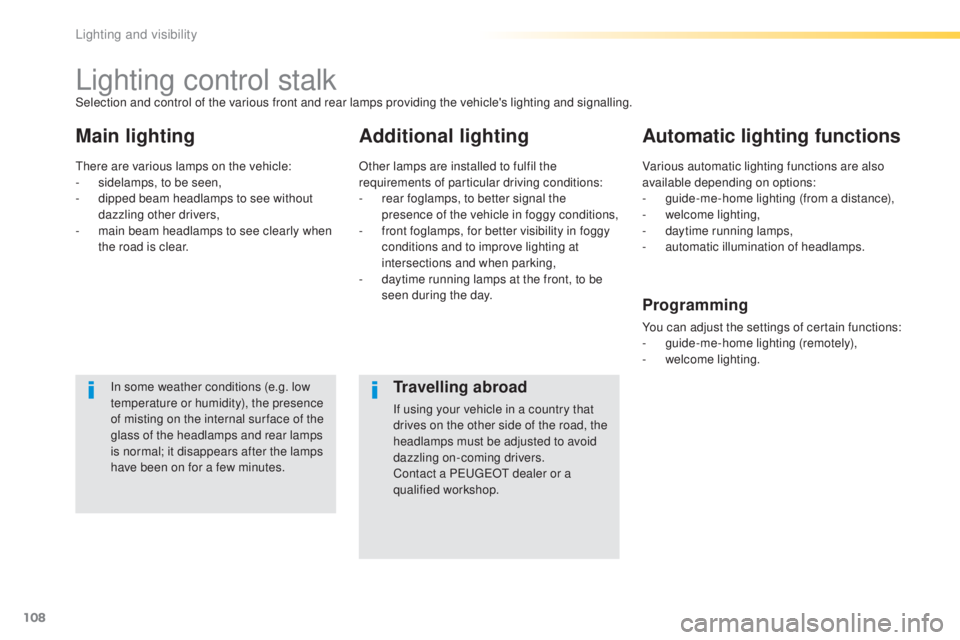
108
308_en_Chap04_eclairage-et-visibilite_ed02-2015
Lighting control stalk
Main lightingAdditional lightingAutomatic lighting functions
In some weather conditions (e.g. low
temperature or humidity), the presence
of misting on the internal sur face of the
glass of the headlamps and rear lamps
is normal; it disappears after the lamps
have been on for a few minutes.
Selection and control of the various front and rear lamps providing the vehicle's lighting and signalling.
the
re are various lamps on the vehicle:
-
si
delamps, to be seen,
-
di
pped beam headlamps to see without
dazzling other drivers,
-
ma
in beam headlamps to see clearly when
the road is clear. Other lamps are installed to fulfil the
requirements of particular driving conditions:
-
re
ar foglamps, to better signal the
presence of the vehicle in foggy conditions,
-
fr
ont foglamps, for better visibility in foggy
conditions and to improve lighting at
intersections and when parking,
-
da
ytime running lamps at the front, to be
seen during the day. Various automatic lighting functions are also
available depending on options:
-
gu
ide-me-home lighting (from a distance),
-
we
lcome lighting,
-
da
ytime running lamps,
-
au
tomatic illumination of headlamps.
Programming
You can adjust the settings of certain functions:
- gui
de-me-home lighting (remotely),
-
we
lcome lighting.
Travelling abroad
If using your vehicle in a country that
drives on the other side of the road, the
headlamps must be adjusted to avoid
dazzling on-coming drivers.
Contact a P
eu
ge
Ot d
ealer or a
qualified workshop.
Lighting and visibility
Page 112 of 398
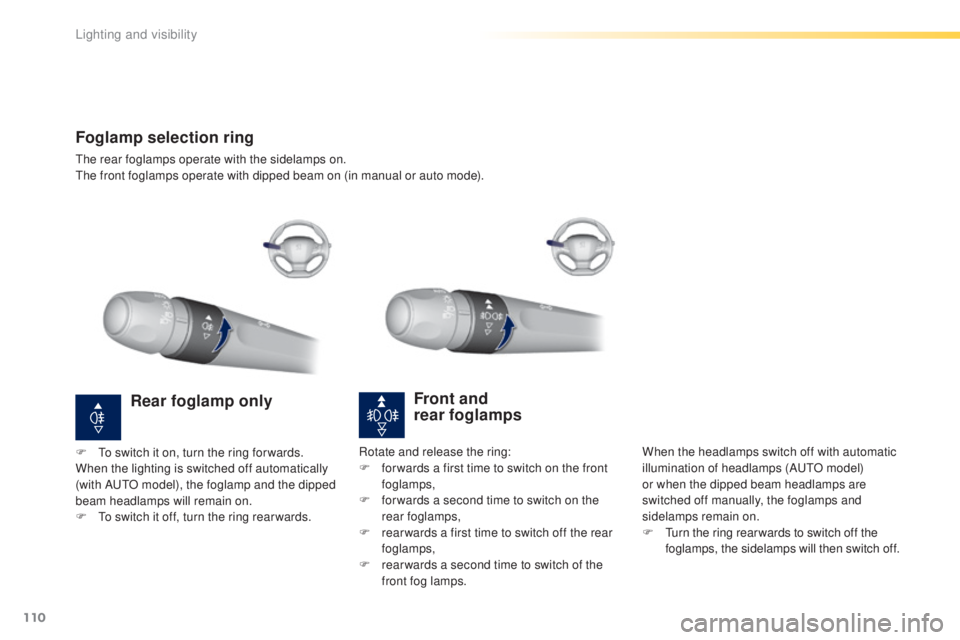
110
308_en_Chap04_eclairage-et-visibilite_ed02-2015
Foglamp selection ring
the rear foglamps operate with the sidelamps on.the front foglamps operate with dipped beam on (in manual or auto mode).
Front and
rear foglamps
When the headlamps switch off with automatic
illumination of headlamps (AutO mo del)
or when the dipped beam headlamps are
switched off manually, the foglamps and
sidelamps remain on.
F
tur
n the ring rear wards to switch off the
foglamps, the sidelamps will then switch off.
Rear foglamp only
F to switch it on, turn the ring for wards.
W hen the lighting is switched off automatically
(with A
utO mo
del), the foglamp and the dipped
beam headlamps will remain on.
F
t
o sw
itch it off, turn the ring rear wards. Rotate and release the ring:
F fo
r wards a first time to switch on the front
foglamps,
F
fo
r wards a second time to switch on the
rear foglamps,
F
re
ar wards a first time to switch off the rear
foglamps,
F
re
ar wards a second time to switch of the
front fog lamps.
Lighting and visibility
Page 113 of 398
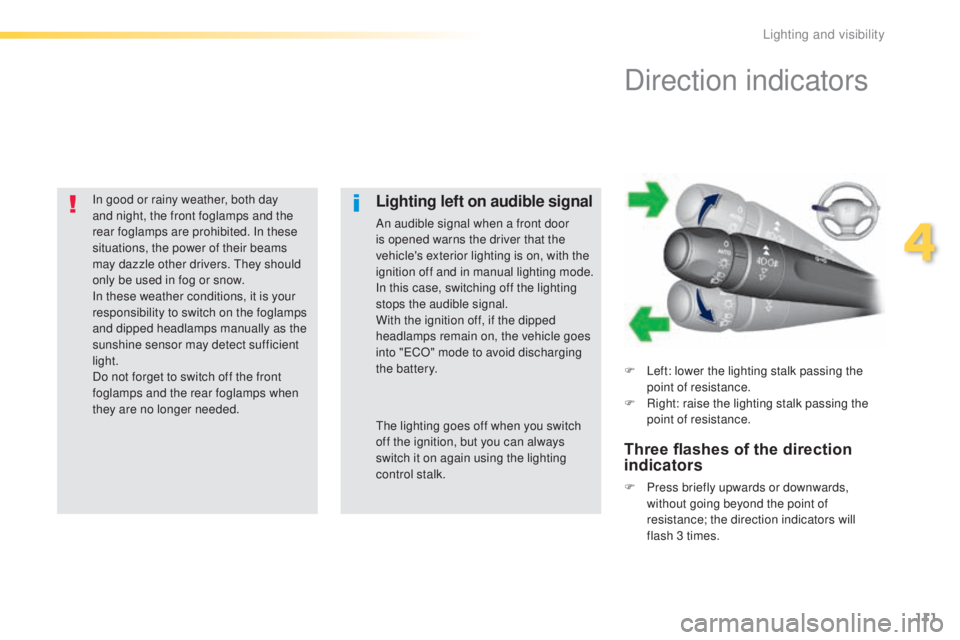
111
308_en_Chap04_eclairage-et-visibilite_ed02-2015
In good or rainy weather, both day
and night, the front foglamps and the
rear foglamps are prohibited. In these
situations, the power of their beams
may dazzle other drivers.
they
should
only be used in fog or snow.
In these weather conditions, it is your
responsibility to switch on the foglamps
and dipped headlamps manually as the
sunshine sensor may detect sufficient
light.
Do not forget to switch off the front
foglamps and the rear foglamps when
they are no longer needed.Lighting left on audible signal
An audible signal when a front door
is opened warns the driver that the
vehicle's exterior lighting is on, with the
ignition off and in manual lighting mode.
In this case, switching off the lighting
stops the audible signal.
With the ignition off, if the dipped
headlamps remain on, the vehicle goes
into "
eCO
" mode to avoid discharging
the battery.
the l
ighting goes off when you switch
off the ignition, but you can always
switch it on again using the lighting
control stalk.
Direction indicators
F Left: lower the lighting stalk passing the
p oint of resistance.
F
Ri
ght: raise the lighting stalk passing the
point of resistance.
Three flashes of the direction
indicators
F Press briefly upwards or downwards,
w ithout going beyond the point of
resistance; the direction indicators will
flash 3 times.
4
Lighting and visibility
Page 114 of 398
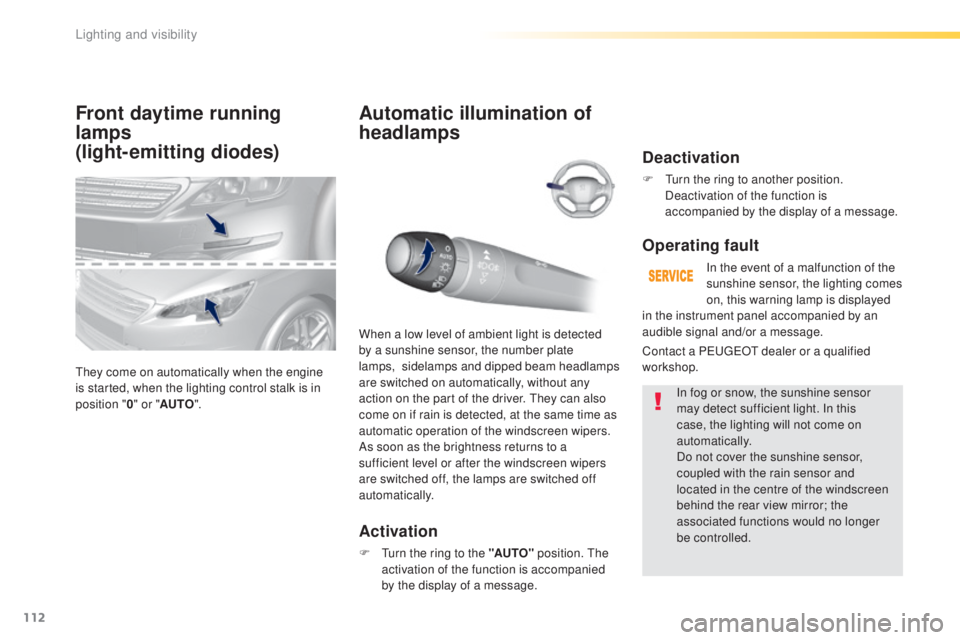
112
308_en_Chap04_eclairage-et-visibilite_ed02-2015
Front daytime running
lamps
(light-emitting diodes)
they come on automatically when the engine
i s started, when the lighting control stalk is in
position " 0" or " AUTO ".
Automatic illumination of
headlamps
Activation
F turn the ring to the "AUTO" p osition. the
a ctivation of the function is accompanied
by the display of a message.
When a low level of ambient light is detected
by a sunshine sensor, the number plate
lamps,
si
delamps and dipped beam headlamps
are switched on automatically, without any
action on the part of the driver.
the
y can also
come on if rain is detected, at the same time as
automatic operation of the windscreen wipers.
As soon as the brightness returns to a
sufficient level or after the windscreen wipers
are switched off, the lamps are switched off
automatically.
Deactivation
F turn the ring to another position.
D eactivation of the function is
accompanied by the display of a message.
Operating fault
In the event of a malfunction of the
sunshine sensor, the lighting comes
on, this warning lamp is displayed
In fog or snow, the sunshine sensor
may detect sufficient light. In this
case, the lighting will not come on
automatically.
Do not cover the sunshine sensor,
coupled with the rain sensor and
located in the centre of the windscreen
behind the rear view mirror; the
associated functions would no longer
be controlled.
Contact a P
eu
ge
Ot d
ealer or a qualified
workshop. in the instrument panel accompanied by an
audible signal and/or a message.
Lighting and visibility
Page 222 of 398
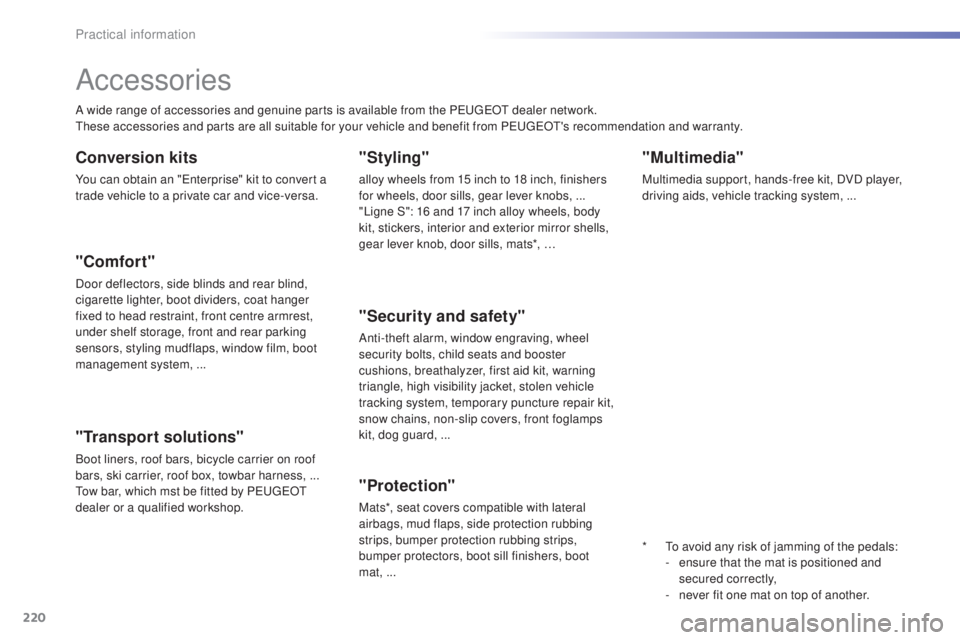
220
308_en_Chap07_info-pratiques_ed02-2015
"Multimedia"
Multimedia support, hands-free kit, DVD player,
driving aids, vehicle tracking system, ...
Accessories
A wide range of accessories and genuine parts is available from the PeugeOt d ealer network.the
se accessories and parts are all suitable for your vehicle and benefit from Peu geOt's r ecommendation and warranty.
"Transport solutions"
Boot liners, roof bars, bicycle carrier on roof
bars, ski carrier, roof box, towbar harness, ...
tow b
ar, which mst be fitted by P
eu
ge
Ot
d
ealer or a qualified workshop.
Conversion kits
You can obtain an "ent erprise" kit to convert a
trade vehicle to a private car and vice-versa.
"Styling"
alloy wheels from 15 inch to 18 inch, finishers
for wheels, door sills, gear lever knobs, ...
"Ligne S": 16 and 17 inch alloy wheels, body
kit, stickers, interior and exterior mirror shells,
gear lever knob, door sills, mats*, …
"Comfort"
Door deflectors, side blinds and rear blind,
cigarette lighter, boot dividers, coat hanger
fixed to head restraint, front centre armrest,
under shelf storage, front and rear parking
sensors, styling mudflaps, window film, boot
management system, ...
*
t
o av
oid any risk of jamming of the pedals:
-
en
sure that the mat is positioned and
secured correctly,
-
ne
ver fit one mat on top of another.
"Security and safety"
Anti-theft alarm, window engraving, wheel
security bolts, child seats and booster
cushions, breathalyzer, first aid kit, warning
triangle, high visibility jacket, stolen vehicle
tracking system, temporary puncture repair kit,
snow chains, non-slip covers, front foglamps
kit, dog guard, ...
"Protection"
Mats*, seat covers compatible with lateral
airbags, mud flaps, side protection rubbing
strips, bumper protection rubbing strips,
bumper protectors, boot sill finishers, boot
mat,
...
Practical information
Page 258 of 398
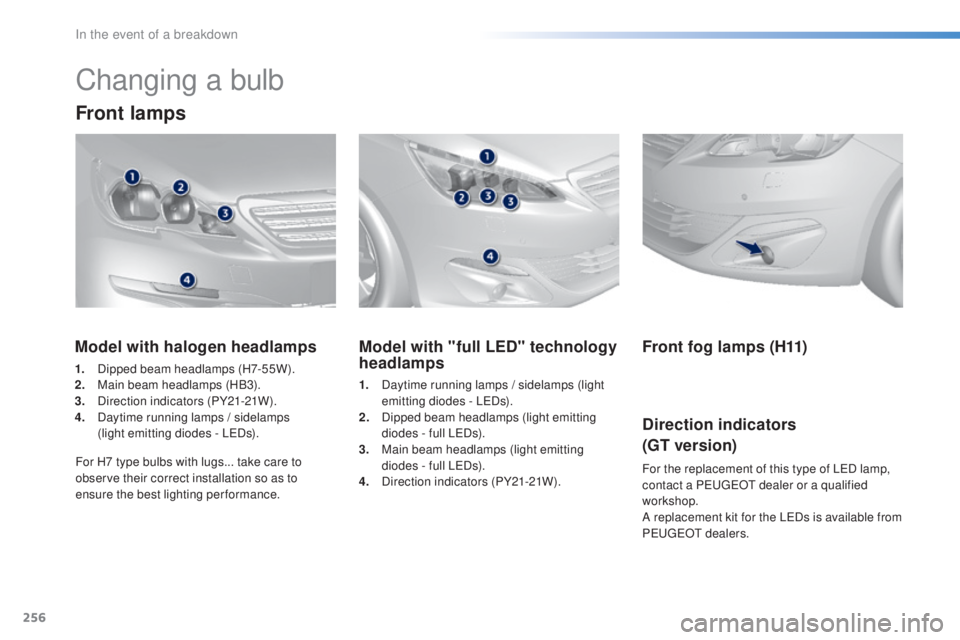
256
308_en_Chap08_en-cas-de-panne_ed02-2015
Changing a bulb
Front lamps
Model with "full LED" technology
headlamps
1. Daytime running lamps / sidelamps (light
e
mitting diodes - LeDs ).
2.
Dip
ped beam headlamps (light emitting
diodes - full L
eDs
).
3.
Ma
in beam headlamps (light emitting
diodes - full L
eDs
).
4.
Di
rection indicators (PY21-21W).
Model with halogen headlamps
1. Dipped beam headlamps (H7-55W).
2. Ma in beam headlamps (HB3).
3.
Di
rection indicators (PY21-21W).
4.
Da
ytime running lamps / sidelamps
(light emitting diodes - L
eDs
).
For H7 type bulbs with lugs... take care to
observe their correct installation so as to
ensure the best lighting performance.
Front fog lamps (H11)
Direction indicators
(GT version)
For the replacement of this type of LeD la mp,
contact a Peu geOt d ealer or a qualified
workshop.
A replacement kit for the L
eDs i
s available from
P
eu
ge
Ot dea
lers.
In the event of a breakdown